Researched by Nelson Banya
CLAIM
A recent tweet by former Finance Minister, Tendai Biti, has re-ignited debate about Zimbabwe’s maternal and child mortality rates.
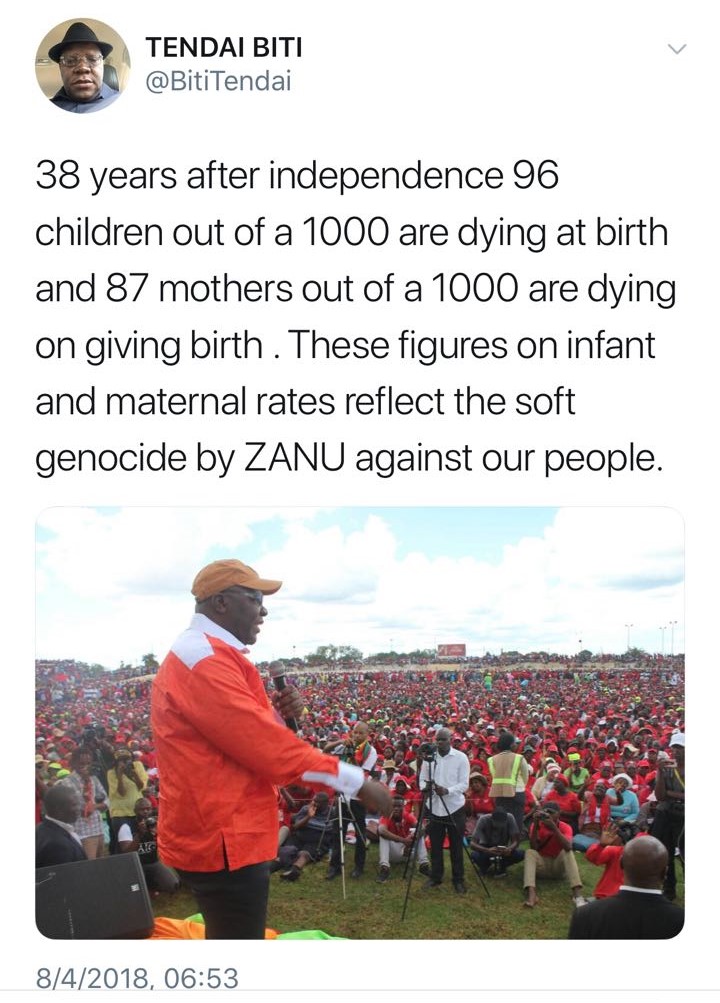
Former Finance Minister and senior opposition official, Tendai Biti’s, tweet
The two indicators are considered key in assessing a country’s socio-economic and human development level.
Zimbabwe’s mortality rates, across the board, spiked between 1992 and 2002, following the trend of HIV prevalence rates, as AIDS-related deaths rose during this period.
A comparison of the 2002 and 2012 Population censuses shows that mortality rates significantly came down between the two censuses, a factor attributed to the availability of anti-retroviral treatment during the latter part of the first decade of the new millennium.
Accurate statistics are, however, hard to find mainly due to incomplete records which result in the use of estimates to come up with some data.
The Zimbabwe National Statistics Agency (Zimstat), the official government data collector, acknowledges that the country’s civil registration data is incomplete.
According to Zimstat’s 2015 Zimbabwe Demographic and Health Survey (ZDHS), only 44 percent of births of children under age 5 are registered, with just a third of the country’s children having a birth certificate.
Similarly, Zimstat concedes that maternal mortality (MMR) is a difficult indicator to measure because of the large sample sizes required to calculate an accurate estimate. As a result, maternal mortality estimates are subject to large sampling errors.
Due to the paucity of data, Zimbabwe relies on surveys such as its population censuses and surveys such as the ZDHS to estimate its mortality indicators.
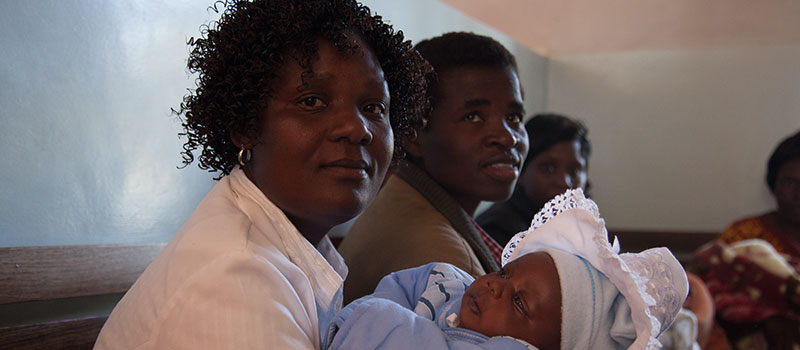
Defining the various mortality rates:
The World Health Organisation (WHO) defines the neonatal mortality rate, which Biti seems to be referring to when he says “96 children are dying at birth”, as the number of deaths during the first 28 completed days of life per 1000 live births in a given year or period. Neonatal deaths (deaths among live births during the first 28 completed days of life) may be subdivided into early neonatal deaths, occurring during the first 7 days of life, and late neonatal deaths, occurring after the 7th day but before the 28th completed day of life. The commonly available data, however, rarely makes these distinctions.
Live birth is defined as the complete expulsion or extraction from its mother, of a product of conception, irrespective of the duration of the pregnancy, which, after such separation, breathes or shows any other evidence of life such as beating of the heart, pulsation of the umbilical cord, or definite movement of voluntary muscles, whether or not the umbilical cord has been cut or the placenta is attached [WHO].
Zimstat defines infant mortality as deaths between birth and the age of 1 year, calculated out of 1000 live births, while child mortality extends the demographic to five years, also expressed in terms of 1000 live births.
WHO defines the maternal mortality ratio (MMR) as the annual number of female deaths from any cause related to or aggravated by pregnancy or its management (excluding accidental or incidental causes) during pregnancy and childbirth or within 42 days of termination of pregnancy, irrespective of the duration and site of the pregnancy, per 100,000 live births, for a specified year.
Zimstat calculates the Maternal Mortality Rate by dividing the number of maternal deaths by the number of women aged 15-49 years.
What does the data say?
Ministry of Health data
The Ministry of Health’s National Health Strategy document for 2016-2020 https://www.unicef.org/zimbabwe/National_Health_Strategy_for_Zimbabwe_2016-2020_FINAL.pdf
says the maternal mortality ratio declined from 960 deaths out of 100 000 live births in 2011 to 614 out of 100 000 live births in 2014. The Ministry of Health, while noting the improvement, says the figure “remains unacceptably high.”
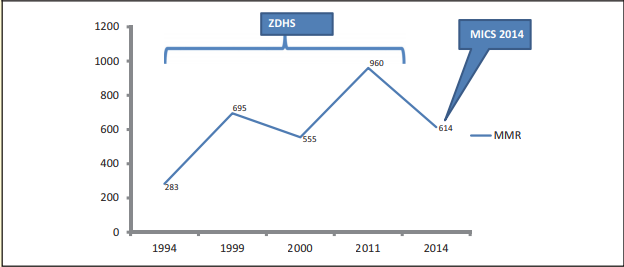
Sources: Zimbabwe Demographic and Health Survey and Multiple Indicator Cluster Surveys
In terms of child mortality, the government document says neonatal mortality was 29 out of 1000 live births in 2014, while the under-five mortality rate was 75 out of 1000 live births.
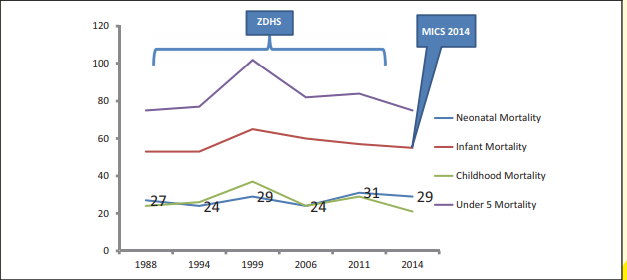
Sources: Ministry of Health, ZDHS and MICS
Zimbabwe National Statistics (Zimstat) data
Zimstat’s 2015 Zimbabwe Demographic and Health Survey (ZDHS) provides mortality data for the seven-year period preceding the survey. The survey itself was conducted between July 6 to December 20, 2015, with a sample of 19483 people in nearly 11000 households (4341 urban and 6193 rural).
Zimstat’s 2015 ZDHS puts the maternal mortality rate at 651 deaths out of 100000 live births in the seven years preceding the survey (2008-2015). This figure was down from 960 deaths out of 100000 live births reported in the 2010-2011 ZDHS, for the 2003-2011 period. The 2005-2006 ZDHS puts the maternal mortality rate for the 1998-2005 period at 612 deaths for every 100000 live births.
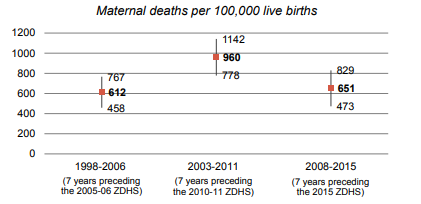
Sources: Zimstat 2015 Zimbabwe Demographic and Health Survey
On child mortality, Zimstat gives the neonatal, infant and under-five mortality rates as 29, 50 and 69 deaths out of 1000 livebirths, in the order, for the 2010-2015 period.
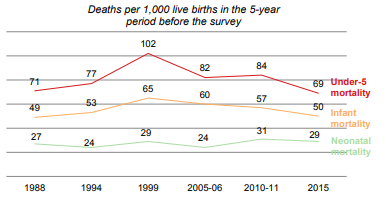
Sources: Zimstat 2015 Zimbabwe Demographic and Health Survey
The World Health Organisation
The WHO states Zimbabwe’s maternal mortality rate as 443 out of 100000 live births in 2015.
The same figure is provided by UNICEF, UNFPA, the World Bank Group, and United Nations Population Division Maternal Mortality Estimation Inter-Agency. http://www.who.int/gho/maternal_health/countries/zwe.pdf
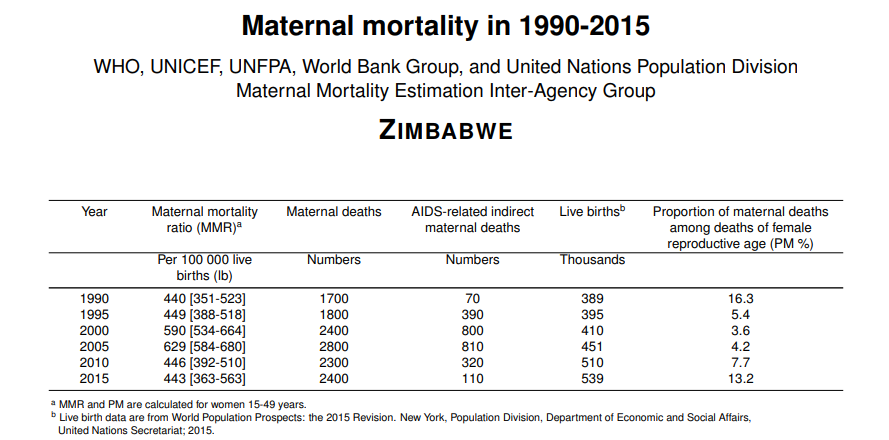
In terms of child mortality, the WHO says Zimbabwe’s neonatal mortality was 23.8 deaths out of 1000 live births in 2015, while the under-five mortality rate is given as 59.9 deaths out of every 1000 live births that same year.
Conclusion
It is evidently difficult to achieve a high level of statistical accuracy when it comes to mortality figures in Zimbabwe and other developing countries with incomplete birth and death records.
The statistics culled from various surveys, due to the lack of accurate direct data, amount to estimates used to track useful trends.
Because these surveys are carried out at different periods and capture various time-frames, the mortality figures tend to vary widely among the sources.
However, the varying figures from government departments and various multilateral agencies (who often collaborate) appear to be within the same ballpark, as shown by the table below:
|
Agency |
Neonatal mortality (out of 1 000 live births) |
Under-five mortality (out of 1 000 live births) |
Maternal mortality rate (out of 100 000 live births) |
| WHO | 23.8 | 59.9 | 443 |
| Ministry of Health | 29 | 75 | 614 |
| Zimstat | 29 | 69 | 651 |
The available data, from official local and international sources, shows Zimbabwe has high rates of child and maternal mortality. However, Biti’s assertions are not supported by any official agency.
About the author: Nelson Banya is ZimFact Deputy Editor-In-Chief.
Do you want to use our content? Click Here











